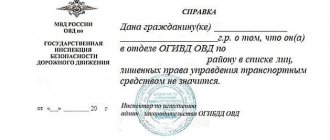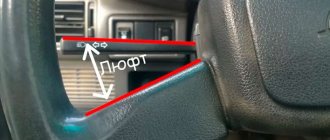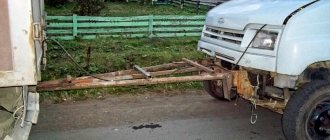Towing a vehicle with a flexible hitch
Towing a car with a flexible hitch is the most common method of towing passenger cars.
A flexible hitch, which is usually a fabric cable, is present in the trunk of almost every car owner. And the point here is not that drivers care about the problems of possible towing. Usually the cable, along with a fire extinguisher, a warning triangle and a first aid kit, is included in the motorist’s kit, so it willy-nilly ends up in almost any trunk.
An example of towing with a flexible hitch is shown in the following picture:
In practice, in addition to the towing cable, special towing mounts will also be required. On some cars, the mounts are lugs that stick out from under the bumpers. On others, you should use a special loop that is screwed into the mount under the plug in the bumper.
It is with a flexible hitch that category B cars are most often towed.
Some towing tips from the experts
Experienced car owners recommend not turning on the emergency lights, ignoring traffic regulations. The fact is that in this case the supply of turn signal signals deteriorates. Also, due to the constantly flashing signs, it is difficult to determine where the car will move. Fog lights are best for this. It is important not to forget that you cannot evacuate on a flexible hitch in icy conditions. You can maintain constant communication with the other driver. A telephone is perfect. Thanks to this approach, it is possible to specifically agree on future actions.
Before you start moving, you need to give the cable tension. This can be done by gradually starting the first car until the second one starts to slow it down. Then the line will tighten. Then you can go. It is best to start moving smoothly. The gear shift should be a little later than usual. And the revolutions should be higher and the shifts sharper. You need to shift faster, as the vehicle's speed is reduced due to additional loads. The car requires high speeds, as it will simply stall during the next shift.
It is important to constantly look in the mirrors. It is necessary to take into account both the speed and distance of the towed vehicle. The cable may sag, so you need to move smoothly. It is important to consider the turning radius. It should be as small as possible so as not to turn the steering wheel on a second car. Since the hydraulic booster does not work when the engine is turned off, then it will be harder to turn the steering wheel. And, because of this, the second driver may not have time to twist the steering wheel to the desired position.
According to traffic regulations, you need to tow at a speed of no more than 50 km per hour. Braking should also be done smoothly. It is important to constantly remember that a towed car cannot brake very quickly, and the total mass will be large, so the braking distance will increase; if the traffic light is flashing green, it is better to reduce the speed in advance. It is important to know that you should not stop on the climbs.
What should it be
What is necessary for successful and authorized transportation of a vehicle by towing:
- Serviceability of brake and steering systems.
- Integrity of the body covering - there should be no breaks or pointed pieces bent outward (if the car has been in an accident).
- Serviceability of door hinges, handles, glass.
- Carabiners and other elements of the connecting device must be in good working order.
- A flexible clutch requires a certain length of cable.
- For rigid fastening - a special device made of durable and high-quality metal.
When transporting a passenger car, a flexible hitch option is suitable. But to transport a truck or passenger vehicle, a rigid hitch is required.
With the latter type of towing, the trajectory of the second vehicle will not deviate. Thus, during travel there will be no unnecessary interference for other participants.
Rope length
The cable should not be shorter than 4 meters and longer than 5 meters. It should be taken into account that the longer the flexible clutch equipment is, the greater the risk of deviation of the trajectory when moving.
If the cable is shorter than the specified norm, then there is a high risk of a collision between the driven vehicle and the vehicle pulling it.
The color of the cable does not matter. The accumulation of steel fibers is impregnated with reflective compounds.
In the case of using a red and white cable with a “reflector” effect, it is allowed not to attach striped signs. Such cables themselves signal and serve as a means of issuing warning signals.
Most often you can find products made from threads of the following shades and their combinations:
- red;
- orange;
- blue;
- blue and white;
- white with red;
- orange and white;
- other variations.
Speed also plays a role in the presence of a particular length of cable. Even driving slowly by the lead driver will not allow the trailing motorist to drive perfectly smoothly.
This is why it is required that the second (transported) car be driven by a person who is always ready to correct the motion vector in a timely manner.
Travel speed
The main postulate of the Rules regarding the speed limit applies to almost all types of vehicles and in all cases of towing. One rule applies to everyone.
Permitted speeds when towing another vehicle:
| within the boundaries of the village | no more than 50 km/h |
| outside the city, town, along the highway | no higher than 40 km/h |
| in case of independent movement of the coupled car | no more than 80 km/h |
| with attached trailer | no more than 70 km/h |
If a car has an automatic transmission and is subject to forced removal from its location on the roadway, then it must be driven exclusively at a speed of 30 km/h - no more.
The only thing is that if the number of gears is more than 3 stages, it is allowed to transport the vehicle at an increased speed, but not more than 50 km/h.
Features of a rigid coupling
This method of towing is carried out using a solid structure, one end of which is attached to the driving vehicle, the other to the driven one. It allows both vehicles to be kept on the same line while driving, which ensures reliability and safety.
Therefore, a rigid vehicle coupling is especially useful for moving heavy, clumsy equipment. It will prevent cars from colliding with each other.
Inventions
Mercedes-Benz has invented an electronic collar for trailers. The new system is called Trailer Stability Assist (TSA). It is fully integrated into the vehicle's existing electronic stability control system. TSA quickly detects the beginning of a skid or lateral sway of the trailer and effectively suppresses these movements by alternately braking the right and left front wheels of the vehicle.
Not all drivers are familiar with the rules for towing vehicles: in driving schools little time is devoted to this section, and in practice, not many have tested themselves as a driver of a towing or towed vehicle.
In a real traffic situation, the lack of theoretical and practical knowledge causes certain difficulties.
Rules for towing with a rigid hitch
Towing a vehicle with a rigid hitch
First of all, traffic regulations prohibit towing in any case if the steering of the towed vehicle is faulty - it can only be transported by partial or full loading. Sometimes they write that when hitching with three attachment points, it is not necessary for the driver to be behind the wheel of the towed car - this is an erroneous idea that contradicts the requirements of the traffic rules.
The driver of the towing vehicle must have at least 2 years of driving experience. The dimensions of the rigid coupling must be such that the distance between the machines is no more than 4 meters. The weight of a towed vehicle with a non-working brake system should not exceed half the weight of the “tug”.
Rules for towing vehicles
A malfunction can happen to anyone, even the most sophisticated car. And if you, as a driver, do not have sufficient experience in repairing a car in the field, or this breakdown cannot be repaired on the road, there is always a way out - towing the car.
Despite the apparent simplicity of the process, there are towing rules that must be strictly followed. Having familiarized yourself with them in advance. By default, in everyone's trunk! The vehicle must have a tow rope. Not a rope or something like twine, not a rope from the school gym, but a tow rope. Today this is not a problem.
Traffic regulations directly prohibit towing in some cases:
- In the case where the actual weight of the towed vehicle without brakes (or with a faulty brake system) is more than 50% higher than the actual weight of the tractor (i.e. the towing vehicle);
- Towing with a flexible hitch during icy conditions. In this case, either towing is carried out using a rigid coupling, or the emergency vehicle is partially placed on a platform or support device;
- During snowfall or when there is no visibility through the windshield;
- Vehicle towing regulations strictly prohibit towing a vehicle with faulty steering by any means other than partially or completely resting on a flatbed.
- It is prohibited to tow motorcycles without a sidecar (side trailer), bicycles, mopeds;
- Towing as a tractor, vehicle with trailer
In addition to the prohibitive towing rules, there are clear and mandatory requirements for the means of towing - a tow rope or a rigid hitch, either conventional or in the form of a so-called. "tie" The length of the rigid coupling should not exceed 4 m, and the flexible coupling should have limits from 4 to 6 m.
Believe me, these rules for towing a car were not invented for another ban, but solely for the safety of both the participants in the towing and the surrounding road users.
When choosing a tow rope for your vehicle, focus on a nylon rope (some use parachute lines for this) with a forged carabiner (hook). The carabiner should preferably have a spring-loaded “pawl” for reliable fixation.
Towing with a rigid hitch
Unlike towing with a flexible hitch, in which the tow rope can sag to the ground, towing with a rigid hitch is carried out using special fixed devices, usually made of metal.
At the same time, towing couplings can be of various designs . The simplest rigid couplers have one attachment point for each vehicle. More complex ones have multiple attachment points to the towed vehicle (as in the picture above) and allow the towed vehicle to follow the path of the towed vehicle while driving in a straight line. The rules for different types of rigid couplings are different.
In practice, towing with a rigid hitch is used much less often than towing with a flexible one. However, rigid couplers have several advantages over flexible ones. For example, they are more durable and allow you to tow heavy trucks.
We recommend: DIY car window tinting
Towing and towed vehicles
To begin with, let’s look at the differences between the concepts of “towing vehicle” and “towed vehicle,” which quite often cause difficulties for drivers who are picking up the rules of the road for the first time.
A towing vehicle is a vehicle that performs towing. It sits at the front and pulls the other vehicle using a flexible or rigid hitch. In the picture above, the towing vehicle is the blue car.
The towed vehicle is the vehicle that is behind, i.e. a car being towed. In the picture, the vehicle being towed is a white car.
Definition of the concept
Towing a car is the manipulation of transporting a car using the traction force of another vehicle and connecting parts. The principle of moving mechanical vehicles is simple - one machine transports another from one place to another.
The following concepts appear in the procedure:
- A towing vehicle is one to which a vehicle that requires forced transportation is attached.
- A towed car is one that is directly transported by a trailer (travels second, attached to the towing vehicle).
- A towbar is a special device at the bottom behind the car that allows it to be used as a tractor. Carabiners and other connecting elements cling to the tow bar.
- “Paws” (hooks, etc.) - are used in front of the car in order to hook the connecting device coming from the towing vehicle (from the towbar).
The towed vehicle must be suitable for stopping in time on the road or adjusting turns.
If the car is not capable of this, then it should be evacuated using special transport equipment. In this case, transporting a car with a broken steering wheel or brakes does not apply to towing.
Is a category necessary?
The driver of a car that is pulling another vehicle on an inflexible device must be quite experienced. But one of the issues that worries motorists in connection with the concept of “rigid coupling” is the category of rights. Some people think that they should be with the letter E, allowing them to carry a trailer heavier than 750 kg.
The definition of the difference between it and a car is in the traffic rules:
“Trailer” is a vehicle that is not equipped with an engine and is intended to be driven in conjunction with a power-driven vehicle.
A motor vehicle is a vehicle driven by an engine. the term also applies to any tractors and self-propelled machines.
Towing of cars is regulated by paragraph 20 of the traffic rules. It does not specify categories of rights. They are discussed in Article 25 of the Law “On Road Safety”. The legal document establishes a special category for each vehicle, as well as for the use of trailers with them. There is no mention of towing here.
It is clear from the traffic rules that a trailer and a car that has lost the ability to move under its own power are different types of vehicles. The law that exists for the use of the former does not apply to the latter. And in order to tow a car, the driver does not need to have the letter E on his license.
Government Decree No. 333 of March 24, 2017 contains a clarification regarding the length of service of a motorist:
When towing, driving towing vehicles must be carried out by drivers who have been licensed to drive vehicles for 2 years or more.
Preparing for towing
Before you start towing, choose its method, and also figure out which of the participants in the process will go in which car. Regarding the method, everything is simple - most everyday situations require towing with a flexible hitch, that is, using a regular cable.
A rigid hitch or partial loading is used when a truck needs to be towed or when the brake system or steering of the towed vehicle is faulty.
It is important that towing is prohibited by the Road Traffic Regulations in icy conditions.
If there is a less experienced driver in the tow than in the towed car, then it makes sense for such drivers to change if possible - so that the more experienced driver pulls the less experienced one, because driving a tug is more difficult. Be sure to agree on the route in detail.
Also, before the start, agree on what the conventional signals mean to each other - blinking high beams, sound signal, hand gestures.
Contrary to what is sometimes believed, the driver of a towed car remains a driver, and does not become a passenger in a car traveling “on a rope.” Therefore, he is subject to the same restrictions as ordinary drivers. For example, have a driver's license with you or not be intoxicated. Accordingly, it is also necessary to have documents for the car and documents confirming the right to drive it.











